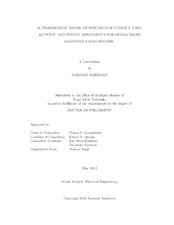| dc.description.abstract | With advances in communications technologies, there is a constant need for higher data rates. One possible solution to overcome this need is to allocate additional bandwidth. However, due to spectrum scarcity this is no longer feasible. In addition, the results of spectrum measurement campaigns discovered the fact that the available spectrum is under-utilized. One of the most significant solutions to solve the under- utilization of radio-frequency (RF) spectrum is the cognitive radio (CR) concept. A valid mathematical model that can be applied for most practical scenarios and also captures the random fluctuations of the spectrum is necessary. This model provides a significant insight and also a better quantitative understanding of such systems and this is the topic of this dissertation. Compact mathematical formulations that describe the realistic spectrum usage would improve the recent theoretical work to a large extent. The data generated for such models, provide a mean for a more realistic evaluation of the performance of CR systems. However, measurement based models require a large amount of data and are subject to measurement errors. They are also likely to be subject to the measurement time, location, and methodology.
In the first part of this dissertation, we introduce cognitive radio networks and their role on solving the problem of under-utilized spectrum.
In the second part of this dissertation, we target the random variable which accounts for the fraction of available subcarriers for the secondary users in an OFDMA based CR system. The time and location dependency of the traffic is taken into account by a non-homogenous Poisson Point Process (PPP).
In the third part, we propose a comprehensive statistical model for user activity, spectrum occupancy, and system throughput in the presence of mutual interference in an OFDMA-based CR network which accounts for the sensing procedure of spectrum sensor, spectrum demand-model and spatial density of primary users, system objective for user satisfaction which is to support as many users as possible, and environment-dependent conditions such as propagation path loss, shadowing, and channel fading.
In the last part of this dissertation, unlike the second and the third parts that the modeling is theoretical and based on limiting assumptions, the spectrum usage modeling is based on real data collected from an extensive measurement. | en |


